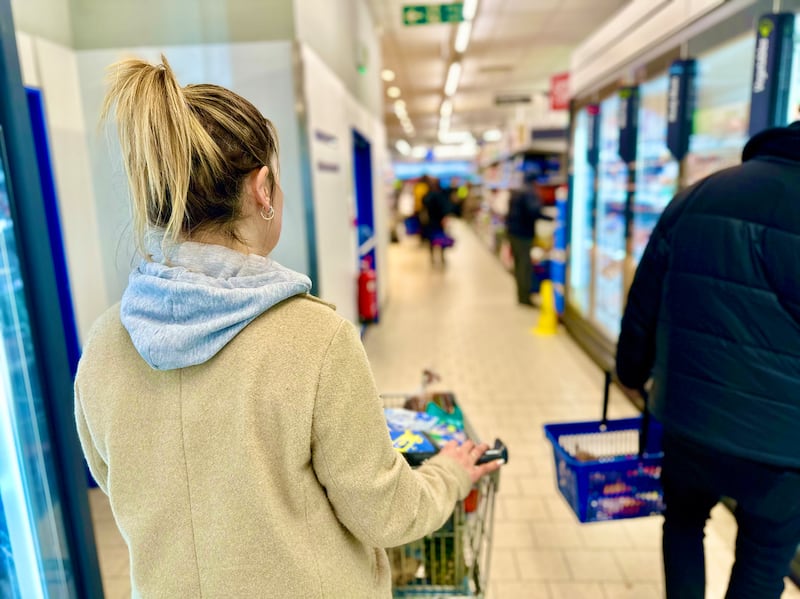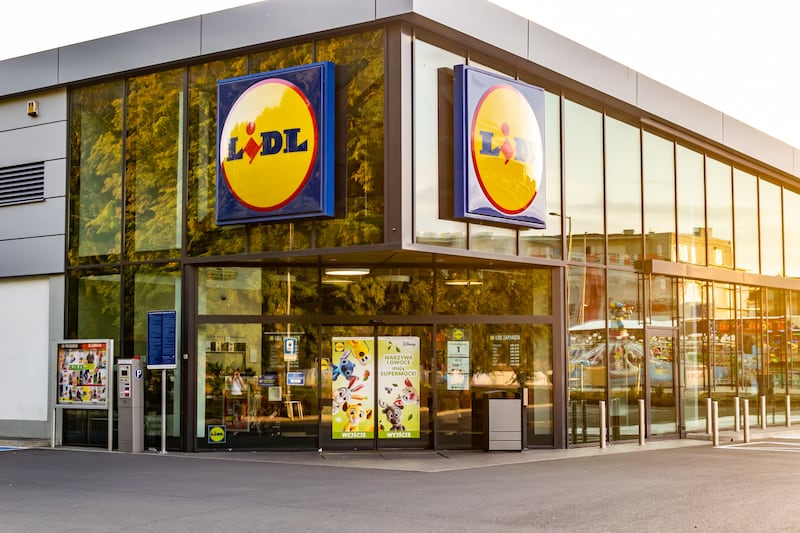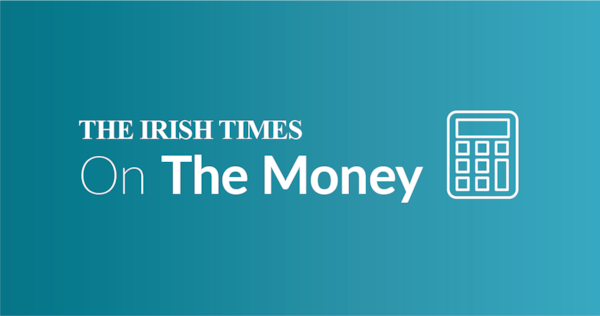It is hard to believe that the end of this week marks the 25th anniversary of Lidl’s arrival in Ireland.
The most popular German discounter we have has certainly come a long way since those heady turn-of-the-century days when Bertie was boss, the economy was on fire and Lidl and its like were treated with wry suspicion, with the very idea that anyone might do an actual big shop in such a place every week as unlikely as being able to buy a blowtorch or an inflatable canoe alongside your beans and bread.
But Lidl took the early, dubious days in its stride and while it is not without its flaws – and we have highlighted some of them on this page over the years – as consumers we’re better off with it than without it. To mark its 25th anniversary we have 25 things we have learned about Lidl since the dawn of the millennium.
1. First, to the most important thing – how do you say it? In Ireland Lidl is a bit of a to-may-to, to-mah-to kind of thing. Some people say LID-ill and some people go with LEED-ill. Pricewatch used to be in the LID-ill camp but in recent years we have moved to the LEED-ill one, although to be honest we are not entirely comfortable with our choices. We’re reliably informed – by Google – that LEED-Ill is how it is said in Germany and they probably know best.
READ MORE
2. And what does Lidl mean? It has a slightly exotic ring to it in this part of the world (in a discounty fashion, like) but it’s a pretty common surname in the country of its birth.
3. Lidl is not, however, the surname of the Lidl owners. The family who own the shop are called Schwarz. Confused? That’s fair. So, the enterprise as we know it now began its journey when Josef Schwarz became a partner in a food wholesalers and distributor in Germany in 1930. His son Dieter opened a handful of retail outlets in the early 1970s and used the surname of Ludwig Lidl, a business partner of his dad – the original business, in case you are ever asked, was called Sudfruchte Grosshandel Lidl & Co. And why wasn’t the Lidl we know today called Schwarz? Well we can’t say for sure but we do know the Schwarz family were not overly keen on publicity then and still aren’t today.
4. The first Lidl opened in 1973 and sold 500 items with three people working in the store. It grew fast and by the end of the 1980s, there were more than 300 Lidls across Germany. The 1990s saw international expansion. Today there are more than 12,000 Lidls in more than 30 countries, and the retailer has an estimated annual turnover of around €130 billion.

5. Lidl and Aldi are not – and we can’t stress this enough – owned by a pair of feuding brothers as the apocryphal yarn will have you believe. The two retailers have absolutely no connection to each other apart from their German roots and sometimes intense rivalry (we will get to that later).
6. Lidl came to Ireland in the middle of July 2000, opening stores in Limerick, Letterkenny, Mullingar, Athlone, Cavan, Ballinasloe and Portlaoise. While it opened more stores on day one than Aldi, its rival got better press, benefiting from first-to-market advantage – having opened the doors to its Dublin and Cork branches almost a year earlier. When Aldi opened there were queues around the block and full-page fun features in this newspaper and others.
When Lidl opened there were stories too but they were more concerned than excited and distinctly resentful.
“The German multinational retail store has told farm representatives that only 8 per cent of the products on its shelves will be Irish produced,” began one such piece in this newspaper.
“Lidl’s policy as outlined to the IFA today is an affront to the Irish public and shows no responsibility to the community from which they draw their profit,” the then head of the IFA, Tom Parlon, said. He stopped short of calling for a boycott but asked the public “to seriously consider why they should support a multinational company which returned so little to the Irish economy and Irish jobs in the Irish food sector.”
Developers didn’t want them in their shopping centres either for fear they would lower the tone, while shoppers were very suspicious of the unfamiliar brands.
“It’s so depressing with all that stuff piled up and the children don’t like the food. But I might have to start going there soon. I’ve just spent €220 at Tesco and didn’t even manage to get the dinner,” one shopper quoted in this newspaper said.
7. We’ve come a long way since then and most people – other than those who work for its rivals and some farmers groups sometimes – would argue that Lidl has been a good-news story for Irish consumers and many small Irish businesses.
The chief executive of Bord Bia, Jim O’Toole, recently said Lidl had “a strong and enduring support for Irish food and drink businesses, many of whom Lidl have worked with for more than 20 years”.
8. In the early days, Lidl had no shopping baskets, only trolleys. This was to save them money and encourage people to buy more – no one wants to wander the aisles of any supermarket with a trolley containing just three things like a crazy person.
9. When it opened it sold fine (in the grand rather than excellent sense) wines for four quid with bottles of beer going for 50 cent a pop. Everything seemed cheap although the layout of the stores with much of the stuff still in packing boxes left something to be desired – at least, that is how it looked to our cosseted consumers.
10. In those early days Lidl did not accept credit cards – as they did not want to pay the fees charged by Mastercard or Visa. They only accepted Laser (remember that?) or cash (remember that?). It was also very quick out the gate when it came to bag charges, charging 11 cent long before the plastic bag levy came in.
11. Almost everything it sold to Irish shoppers was unfamiliar so it offered a money-back guarantee to anyone who didn’t like the taste of what they bought there. This was designed to counteract any reluctance on our part to buy private label.

12. The guarantee was probably a good idea as Irish shoppers had a deep distrust of private label back then. When Lidl opened its doors around 5 per cent of a typical shopping basket was made up of own-brand. Today at least half of everything we buy in our supermarkets is own-brand, with all the supermarkets, including Dunnes, Tesco and Supervalu (which sell huge volumes of both branded and own-brand products) benefiting from the switch.
13. Lidl (and Aldi) struggled for years as we were long confused by the discounter model. We joked about popping in to buy the exotic German hams and the weird middle aisle stuff but it wasn’t really the place for the big shop. Then the crash happened and all the cash we thought we had disappeared. It was a game-changer for Lidl – and Aldi.
14. It would be wrong to suggest that the only reason Lidl’s fortunes changed was because our fortunes changed during the great economic unpleasantness. It spent a long time cultivating relationships with Irish suppliers and growing its product lines and over time it won people over not just on price but on quality.
15. Lidl’s turnover in Ireland is now over of €2 billion, it stocks a huge amount of Irish-sourced products and it has undoubtedly kept other retailers on their toes.
16. And it has undoubtedly saved Irish shoppers money. Its ranges are routinely around 30 per cent cheaper than comparable branded products. Switching just 50 per cent of a big weekly shop from branded to own brand – either with Lidl, Aldi, Dunnes, Tesco or SuperValu – could save someone at least €1,500 a year. If we use basic maths, an early Lidl adopter who went all in on private label when it first came to town might be as much as €37,500 richer today as a result.
17. While Irish consumers are more price sensitive than they were at the turn of the century, they will never be as sensitive to prices as Lidl. Just how sensitive it is became clear in 2018 after details of a grocery price survey commissioned by Aldi and carried out by Grant Thornton found that Aldi was cheapest of them all. To reach its conclusion the firm did a series of price comparison shops on consecutive days across the five main supermarkets and focused on mid-range own-brand products.
The basket of 62 items was found to cost on average €65.04 in Aldi, €65.53 in Lidl, €76.54 in Tesco, €80.74 in Dunnes Stores and €95.50 in SuperValu.
While only 49 cent - or less than the price of small bottle of cheap beer – separated Aldi and Lidl, the latter went ballistic, with the case ending up in the High Court.
To be fair to Lidl, it was able to point to some discrepancies in the survey and while 49 cent might not make much difference to most people, the survey – had it gone unquestioned – would have given Aldi bragging rights as the “cheapest” supermarket in Ireland.
[ Lidl wins High Court action over price survey commissioned by AldiOpens in new window ]
That wasn’t the only Lidl row. In 2008 a store war broke out between it and Tesco after the UK retailer launched a promotional campaign promising new ranges at lower prices. It was aimed at stopping customers switching to Lidl and Aldi.
Within 48 hours Lidl launched an aggressive advertising campaign urging consumers not to spend their “cash on trash”, which was how it described some of products in the new Tesco range.
18. Court spats and store wars aside, Lidl kept growing. Last year it contributed €997 million to Irish GDP and spent €1.3 billion with a network of around 400 Irish suppliers – an increase of 70 per cent over just five years. “Their growth story has been truly remarkable – from a new entrant disrupting the Irish retail market to becoming a household name rooted in communities across the country," the Minister for Finance Paschal Donohoe said recently.
“Their support for the Ladies’ Gaelic Football Association and their emergence as one of Ireland’s most desirable employers reflects a deep and lasting commitment to Ireland, our economy, and our people.”
19. It employs more than 5,500 people, with thousands more jobs across its supply chain.
20. One of the new stores will only be open to a very select few. The new Lidl in Carrigstown, the fictional north Dublin suburb on the RTÉ soap opera Fair City, is said to be one of the largest product placement deals on Irish television.
21. Lidl has three enormous distribution centres, including one in Mullingar which is the same size as four Croke Parks – the universally accepted measure of big things in Ireland.
22. Like most operators in the cut-throat Irish grocery market, Lidl does not file public accounts so it is hard to say how much money it makes from us.
23. For many years it eschewed the merits of loyalty schemes on the grounds that they cost money. But a few years back it launched the Lidl Plus scheme which offered users of its app rewards. And in recent weeks it launched Lidl Points, with shoppers who use the Lidl Plus app getting one point for every €1 spent which they can use to buy stuff or coupons.
24. It is promising to open what it says is Ireland’s first net-zero supermarket, in Maynooth, later this year. All its operational energy will come from on-site renewable sources.
25. While it has grown fast and now has almost 200 stores and a market share of about 14 per cent, much hasn’t changed. It still has fewer products that a mainstream supermarket – there might be around 2,000 products on its shelves compared with 20,000 in a really big Tesco. And of course there is the middle aisle with its eclectic mix of clothes, power tools, toys, kitchen equipment, animal houses, tents, blowtorches, laminating machines, clothes dryers, wetsuits, hedge trimmers and almost everything else you can possibly imagine.
‘I bought a machine for riveting jeans ... God knows what I was thinking’
More than once in recent years, Pricewatch has been found outside a Lidl in the early morning waiting for the doors to open so we could race in and buy something that was deemed essential.
We’ve never been alone.
Whether it is some class of wrought-iron garden furniture or a set of wetsuits to help us get through a summer in Ireland, we’ve always been joined by other canny shoppers well aware that the most sought-after items in the most sought-after sizes tend to disappear from the middle aisles within minutes of them going on sale.
And – if we might borrow a phrase from another retailer – when it comes to the random assortment of things found selling in the Lidl middle aisle, when they are gone they are gone.
That sense of urgency is one of the things Lidl capitalises on.
While other retailers sell tellies and toasters and clothes and waffle makers too, they more often than not devote a permanent space for them so shoppers don’t feel under pressure to buy when Sunday comes out of fear that if they don’t buy that air fryer or weighing scales or inflatable canoe or angle grinder immediately they may never get the chance again.
Men are more guilty than women when it comes to dubious middle aisle buys, Lidl’s UK boss Ryan McDonnell told the BBC recently. “We often get partners at odds with each other because men have disappeared up the aisle and are buying things they maybe already have,” he said.
Its Parkside brand of power tools is now one of Europe’s biggest-selling DIY brands. Mind you, we can’t be sure it’s Europe’s most widely used DIY brand because the limited stock and sense of urgency that comes attached to the products, as well as what look like competitive prices, must see many of the products bought but never used.
Pricewatch was on The Last Word on Newstalk recently when a guest presenter asked if the middle aisle was a loss leader, designed to attract people through the doors with the promise of cheap drill bits, after which they buy their groceries too.
The suggestion could scarcely be further from the truth. While Lidl does not talk in any great detail about its margins or how much it makes on its middle aisle stock (a feature it shares with pretty much all the supermarkets operating in the Republic) industry sources have suggested that the margins on middle aisle stock are probably in excess of 10 per cent – significantly higher than humble groceries.
With that in mind, we asked readers for their best, worst or just most insane middle aisle buy. Here are just a sample of the responses.
My husband bought a battery-powered pepper grinder with a light ... For those times when he was low on energy, in a power outage and still needed well-seasoned food. It was hideously inefficient and he’s quoted as saying “you’d get one dinner out of 8 AA batteries”. Edel Ni Laocha
A connection for an air compressor. I don’t have an air compressor ... self inflicted really. Shane Cusack
An electric weed burner. Used once for a frustrating half an hour. Hanging in shed for past three years. Bernadette O’Reilly
Not weird or useless, I suppose, but I bought an electric paint sprayer 15 years ago to paint the wall in the back garden, I put the paint in it but unfortunately I used the wrong paint so the spray point got blocked and, lazy as I am, I couldn’t be bothered cleaning it so I dumped it. Anthony Horgan
Gym gear that I never used and haven’t a hope of fitting into now. Sean O’Reilly
A giant bottle of motor oil. I didn’t own a car at the time. Steve Boylan
A pool for the dog – she won’t even drink out of it, let alone get in it. John Mannion
A fishing stool, rod and bait box. I’ve never fished in my life. Gerard O’Sullivan
An egg boiler, because using a pot wasn’t complicated enough. Nancy
Riveting machine. Yeah, for like ... jeans and belts. God knows what I was thinking. Adam
Not me but I know someone who bought TWO angle grinders because such good value. Then they admitted they had no use for one. Dermot Ryan











